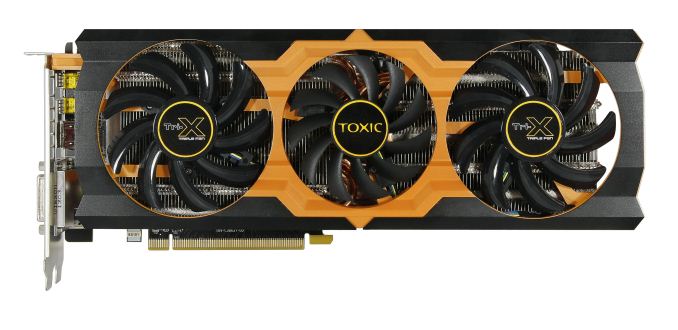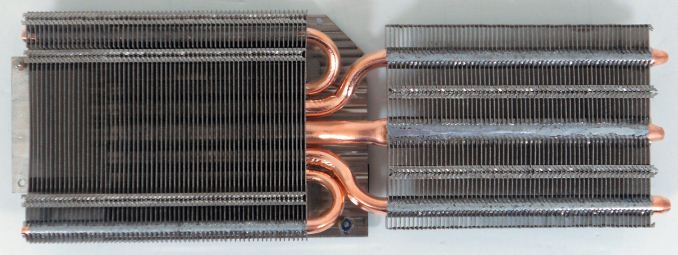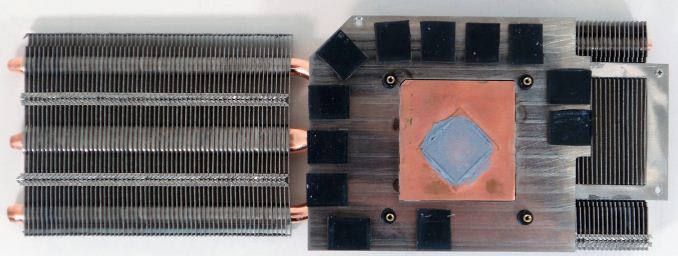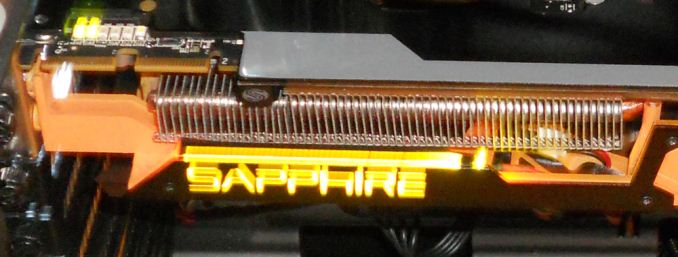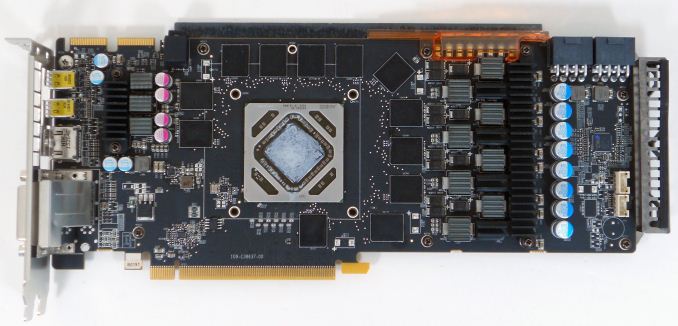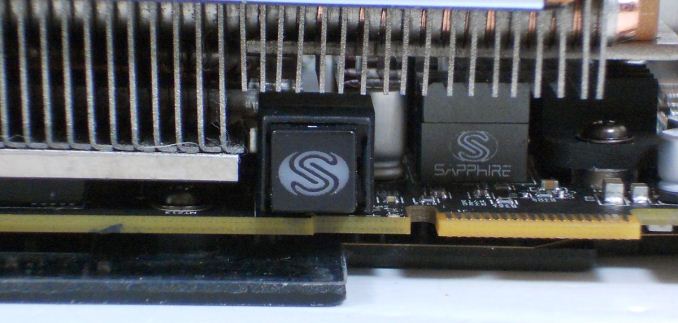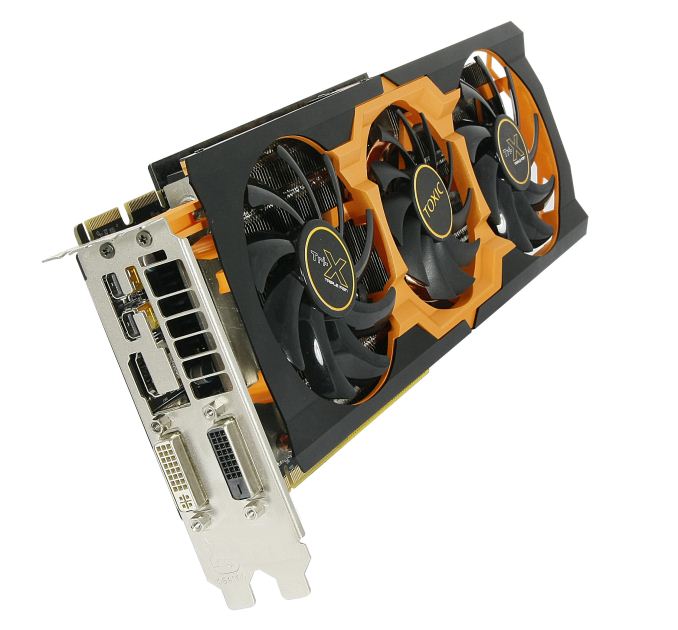
Original Link: https://www.anandtech.com/show/7406/the-sapphire-r9-280x-toxic-review
The Sapphire R9 280X Toxic Review
by Ryan Smith on October 10, 2013 8:00 AM EST- Posted in
- Radeon
- Sapphire
- GPUs
- Tahiti
- Radeon 200
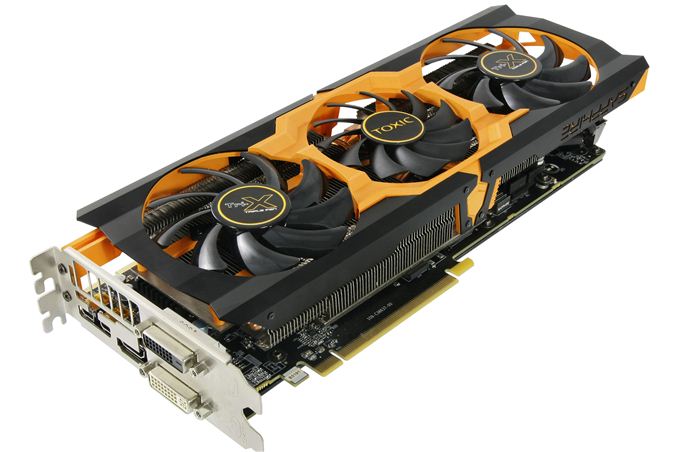
With AMD’s Radeon R9 280X being based on the company’s now venerable and battle-tested Tahiti GPU, AMD’s partners have wasted no time in releasing fully customized products for AMD’s new lineup. Whether it’s reusing a tried and true design from the 7970 and 7970 GHz Edtion, or coming out with a new design entirely, everyone is doing something to make their card unique. In fact you won’t even find a reference card for the 280X launch; everything is custom from day one.
Of course it’s not just boards and coolers that can be adjusted. With nearly 2 years knowledge on the performance characteristics and yield curves of the Tahiti GPU, partners aren’t wasting any time in releasing aggressively clocked designs in their first salvo. We’ve already seen Asus make their first move with their R9 280X DirectCU II TOP, and they won’t be alone. But of all the designs being released in the next week for the 280X, none that we’re aware of are quite as aggressive as what Sapphire will be going for with their 280X Toxic.
| AMD GPU Specification Comparison | ||||||
| Sapphire R9 280X Toxic | Asus Radeon R9 280X DCU II TOP | AMD Radeon HD R9 280X | AMD Radeon HD 7970 GHz Edition | |||
| Stream Processors | 2048 | 2048 | 2048 | 2048 | ||
| Texture Units | 128 | 128 | 128 | 128 | ||
| ROPs | 32 | 32 | 32 | 32 | ||
| Core Clock | 1100MHz | 970MHz | 850MHz | 1000MHz | ||
| Boost Clock | 1150MHz | 1070MHz | 1000MHz | 1050MHz | ||
| Memory Clock | 6.4GHz GDDR5 | 6.4GHz GDDR5 | 6GHz GDDR5 | 6GHz GDDR5 | ||
| VRAM | 3GB | 3GB | 3GB | 3GB | ||
| Typical Board Power | >250W | >250W | 250W | 250W | ||
| Width | Double Slot | Double Slot | Double Slot | Double Slot | ||
| Length | 12.25" | 11.25" | N/A | N/A | ||
| Warranty | 2 Years | 3 Years | N/A | N/A | ||
| MSRP | $349 | $309 | $299 | N/A | ||
Meet The Sapphire R9 280X Toxic
Clocked at 1100MHz for the base GPU clock and 1150MHz boost GPU clock, with the their 280X Toxic Sapphire is aiming to have the fastest 280X card on the market. This is 250MHz (29%!) faster than the stock 280X at base clockspeeds, and 150Mhz (15%) faster under full boost. This is a very high and very narrow range of clockspeeds that according to the various 280X card specs we have so far makes the 280X Toxic the highest clocked card on the market, and one that will always be performing very close to its peak clockspeeds thanks to that narrow boost range. To that end 1150MHz is by no means unheard of for a Tahiti overclock, but by our reckoning it is towards the tail end of what a good Tahiti GPU can do under a reasonable voltage and air cooling, so Sapphire dipping well into the tail end of the yield curve to bring this card together. In any case, complementing the GPU overclock is a smaller memory overclock of 400MHz (7%) to keep the GPU fed.
Meanwhile cooling Sapphire’s highly clocked beast is a new cooler design out of Sapphire that is not necessarily the largest of the dual-slot GPU coolers, but certainly among the longest at 12.25 inches. Dubbed the Tri-X cooler, Sapphire is using a 3 fan asymmetrical design that takes a pair of 90mm fans with an 80mm fan in the center to provide all of the airflow the card needs. In that respect this is fairly typical for a triple fan open air cooler, though making Sapphire one of only a couple of companies to use this design in any product in lieu of a dual fan design.
Located below and measuring just a bit shorter than the fan-shroud is the 280X Toxic’s heatsink, a two segment vertical fin design. Sapphire is using 5 copper heatpipes to move heat between the GPU and the heatsink, with two pipes going to the first segment located over the GPU while the other three go to the segment at the tail end of the card, with the largest of these heatpipes measuring 10mm in diameter and tying it for the largest heatpipes we’ve seen yet.
Pulling away the heatsink we can find a couple of other heatsinks and a baseplate to pick up the slack for what the primary heatsink can’t cover alone. A baseplate attached to the larger heatsink segment provides cooling for the Hynix RAM chips and other discrete components around the GPU, while another strip heatsink is attached to the MOSFETs that are part of the card’s voltage regulation equipment. This smaller heatsink isn’t attached to the primary heatsink in any way, so cooling comes off of the airflow from the fans.
On the back side of the card we’ll find a backplate that Sapphire has attached to the card and runs the full length of the PCB. There aren’t any components on the back of the card that the backplate provides direct cooling for, but it does provide another heat outlet for the MOSFETs on the front of the card, with a strip of thermal material connecting the backplate to the location on the PCB where the MOSFETs are. The backplate also provides some protection for the chokes Sapphire has placed on the back of the card, as the backplate sticks out farther than the chokes. Meanwhile for those who like to show off or otherwise have their video card visible, on the back we’ll also find Sapphire’s LED temperature LEDs, a series of 6 LEDs that will light up in accordance with the GPU temperature.
Meet The Sapphire R9 280X Toxic, Cont
Moving on to the electronics of the 280X Toxic, Sapphire has equipped the card with their standard high-end “black diamond” solid chokes and solid capacitors. The use of solid state parts on high end cards is typical for everyone these days, so about the only thing that sets Sapphire apart here is the physical design of their chokes, which uses a number of fins to give their tops additional surface area for a heatsink-like heat dissipation effect.
Like some of the other 280X cards we’ve seen, Sapphire has gone with a 10 phase power implementation on their card to give the card more headroom on the power side, outfitting the card with 8 power phases for the GPU as opposed to the typical 5 phases, and the same 2 phase memory/IO setup. Sapphire is operating the card at an above-spec voltage of 1.256v, so the additional phases are crucial in delivering the higher wattage this card draws on to operate.
Also found on the card is a push-button BIOS selection switch for dual VBIOS functionality. For the retail cards one VBIOS will be for use with standard PC BIOS systems, while the second VBIOS will be for UEFI systems. Our press sample didn’t come with the UEFI VBIOS so we weren’t able to test that for this article. Of course the presence of the second BIOS also allows for safer BIOS modding, for those inclined to do that.
Overall, and with an immediate preface that I don’t have any reason to believe the shipping retail cards will be like this, the build quality on our press sample was relatively poor. As is sometimes the case this card was assembled by hand in order to get it to us early enough ahead of the retail shipments for today’s review. These hand assembled cards are hit and miss and in this case ours was a miss, with a pair of shroud screws having come out of place. The end result being that the tail end of the shroud (farthest from the GPU) wasn’t secured and could easily move several millimeters away from the card.
This didn’t impact our testing in any way, and we were able to fix the problem after fully disassembling the card. But it does highlight the fact that the only real weakness in Sapphire’s design is that the shroud isn’t mounted to the heatsink/PCB in enough points, particularly towards the rear. The retail cards will have the same limited number of mounting points, but given what’s happened in the past with other dodgy hand-built press samples I’m not expecting those cards to have the screw problem, though it is something we’ll be keeping an eye on as these cards hit retail.
Meanwhile overclockers will want to pay note that overclocking options on the 280X Toxic will be limited. The card has solid power delivery, however there isn’t any voltage control on the card – Sapphire Trixx, MSI Afterburner, and Asus GPU Tweak are unable to set a different voltage – so you can only overclock it as far as the default voltage will take you. In that respect Sapphire has clearly designed the card for stock operation as opposed to satisfying that end-user overclocking itch.
While we’re on the subject of overclocking, Sapphire’s Trixx overclocking utility works with this card out of the box, but unfortunately it hasn’t changed much since the last time we’ve seen it. It’s still competent at overclocking, but it lacks any good monitoring features, so anyone intending to chase overclocking will probably want to stick to Afterburner for this.
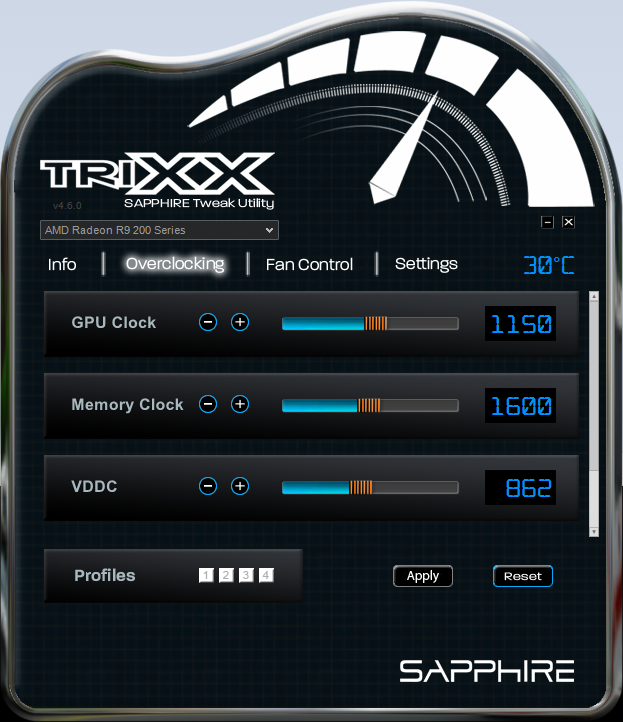
Moving on, let’s briefly talk about I/O and other connectivity. Sapphire has opted for the Radeon standard of 1x DL-DVI, 1x SL-DVI (physically DL-DVI), 1x HDMI, and 2x Mine DisplayPort 1.2 for connectivity, so the card should be able to easily drive anything thrown at it. Meanwhile at the top of the card are a pair of 8pin PCIe power sockets; though the card shouldn’t need more than 300W at stock, given the amount of power we do see it draw and the PowerTune limits when overclocked, the additional 75W offered by the second 8pin connector is a solid idea in this case.
Finally, let’s quickly talk warranties and pricing. Sapphire is offering their standard 2 year warranty with this card, which although not particularly short does make it the shortest among all of the 280X cards we’ve looked at so far. Meanwhile pricing is what you’d expect for such a heavily overclocked card, with Sapphire releasing the card at $349, a full $50 (17%) higher than the MSRP for a stock 280X. The card is quite a bit faster than a standard 280X – 13% faster on average – so Sapphire isn’t out of line here, but they won’t be improving on the price/performance ratio over standard cards.
Gaming Performance
As far as gaming performance is concerned, as the highest clocked 280X card we’ve reviewed there’s actually not a lot to say about performance. The card will flat-out outperform every other 280X and it will even outperform NVIDIA’s GTX 770 on average. As we’ll see in our overclocking section, at stock it even outperforms our 280X cards when overclocked. So Sapphire certainly won’t be lacking in performance here.
Finally, please note that since we don’t have a reference 280X here, we’ll be using XFX’s 280X – a stock clockspeed part – as a proxy.
| CPU: | Intel Core i7-4960X @ 4.2GHz |
| Motherboard: | ASRock Fatal1ty X79 Professional |
| Power Supply: | Corsair AX1200i |
| Hard Disk: | Samsung SSD 840 EVO (750GB) |
| Memory: | G.Skill RipjawZ DDR3-1866 4 x 8GB (9-10-9-26) |
| Case: | NZXT Phantom 630 |
| Monitor: | Asus PQ321 + Samsung 305T |
| Video Cards: |
Sapphire Radeon R9 280X Toxic XFX Radeon R9 280X Double Dissipation Asus Radeon R9 280X DirectCU II TOP AMD Radeon HD 7970 GHz Edition NVIDIA GeForce GTX 780 NVIDIA GeForce GTX 770 |
| Video Drivers: |
NVIDIA 331.40 Beta AMD Catalyst 13.11 Beta 1 |
| OS: | Windows 8.1 Pro |
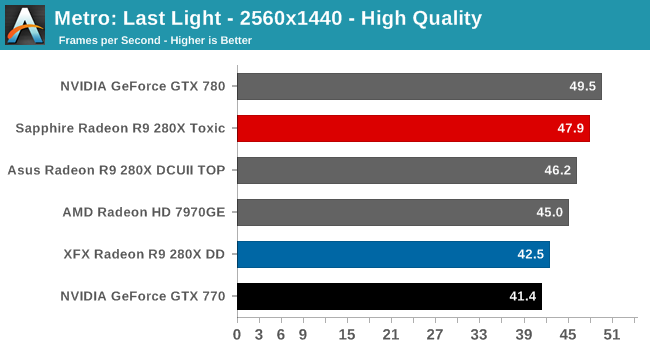
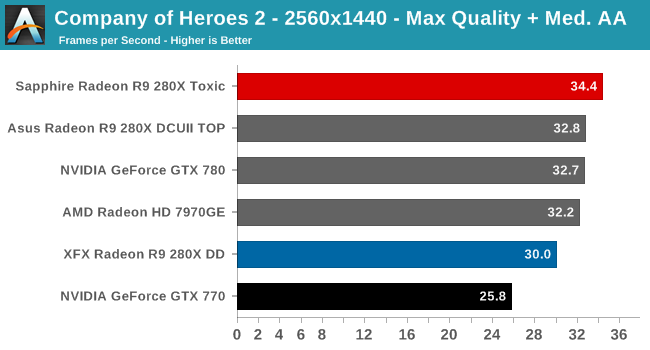


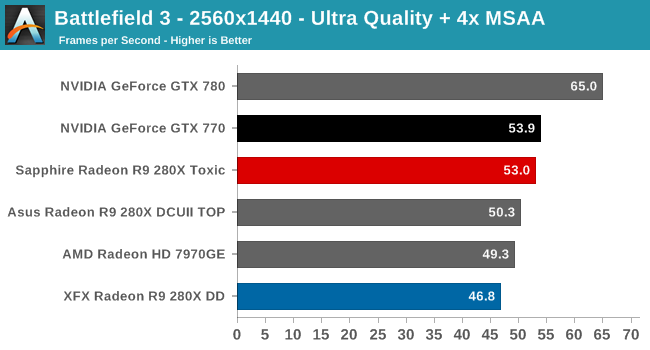

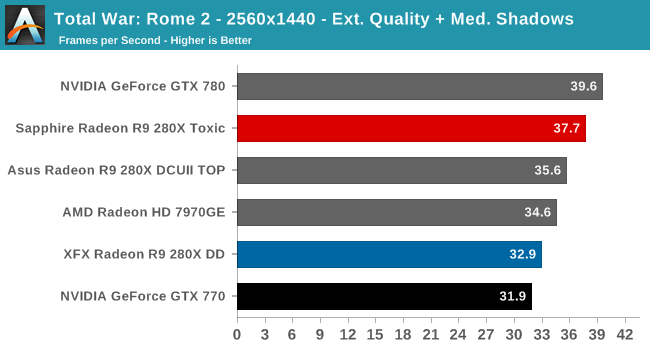
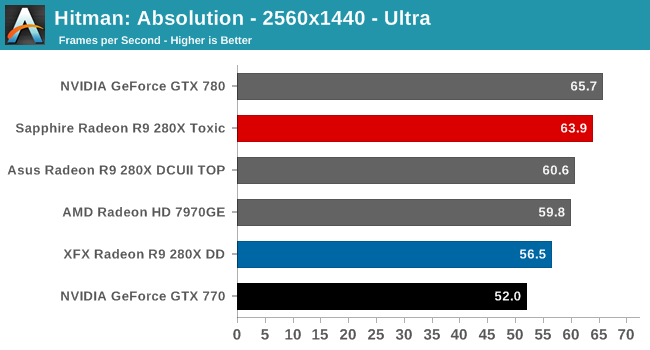
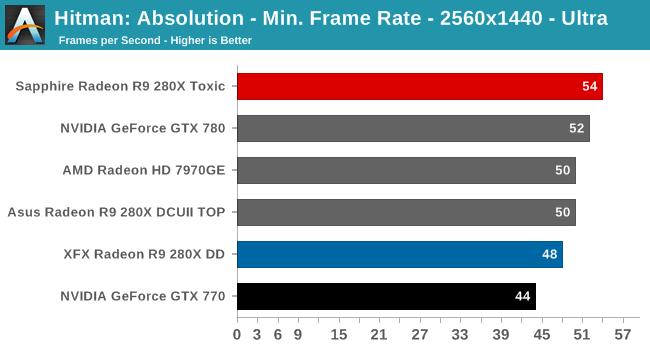
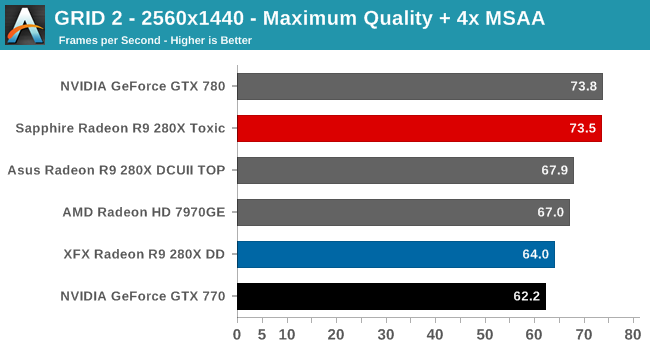
In the end Sapphire’s 280X Toxic is 13% faster than a stock clocked 280X. The stock 280X is usually boosting to near its maximum levels, so the performance gains from Sapphire’s overclock trends closer to the theoretical gains from the gains in the boost clock as opposed to the theoretical gains from the base GPU overclock. This also means it’s several percent faster than the GTX 770 on average, while still costing $50 less; though this won’t account for any factory overclocked GTX 770s that we’ve seen are out there.
Power, Temperature, & Noise
Having seen the gaming performance of the 280X Toxic, let’s move on to power, temperature, and noise to get a better look at the performance characteristics of Sapphire’s Tri-X cooler. This will also give us a chance to evaluate the costs of Sapphire’s significant factory overclock with respect to power consumption.
| Radeon 280X Series Voltages | ||||||
| Sapphire 280X Boost Voltage | Sapphire 280X Base Voltage | Asus 280X Boost Voltage | XFX 280X Boost Voltage | Ref 7970GE Boost Voltage | ||
| 1.263v | 1.2v | 1.2v | 1.2v | 1.218 | ||
At the base GPU clockspeed of 1110MHz Sapphire is able to stick to 1.2v for their GPU voltage, but to boost up to 1150MHz they have to go to 1.256v. This is high for a Tahiti chip, and although still in the safe zone for something with this large an air cooler it is reaching about as high as we like to take Tahiti while maintaining longevity.

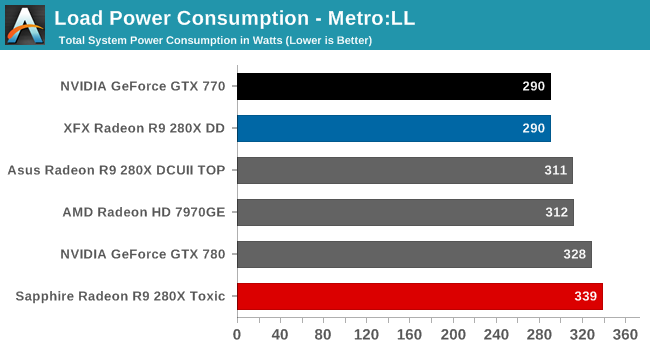
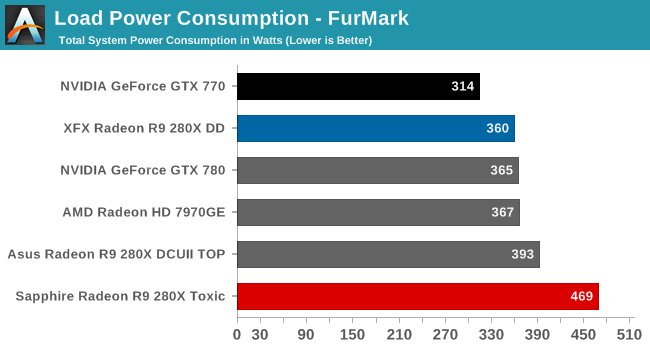
With the increased clockspeeds and voltages, rather expectedly we see an increase in power consumption. 339W (at the wall) under Metro is nearly 50W more than the stock 280X, and still 28W more than the overclocked (but not overvolted) Asus card. In fact it’s more than even the GTX 780, a card that still beats the 280X Toxic in our benchmarks.
FurMark shows a similar trend, with the 280X Toxic sustaining a load over 100W more than the stock 280X, or the GTX 780 for that matter. Sapphire has clearly set the PowerTune limit on their card higher in compensation for the amount of power a higher clocked, higher voltage GPU will take, and they have the cooling to back it up, letting the card draw this much power and sustain it. FurMark is a pathological case and gaming power consumption will be much closer to the Metro scenario, but it does show how high the Sapphire card can go under extreme load.
Consequently it’s clear that Sapphire has regressed some on the power curve to hit their performance targets. 1150MHz is unquestionably outside Tahiti’s sweet spot, so there is a significant power penalty to pay to get there.
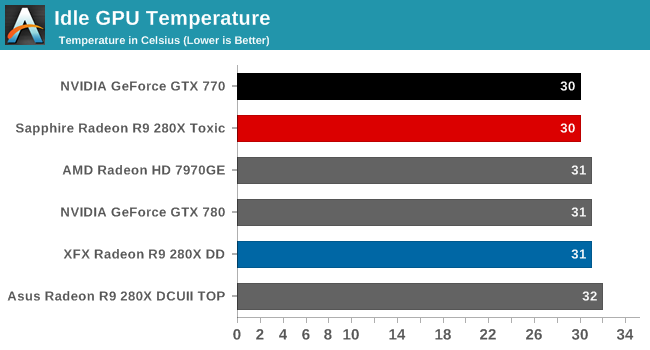
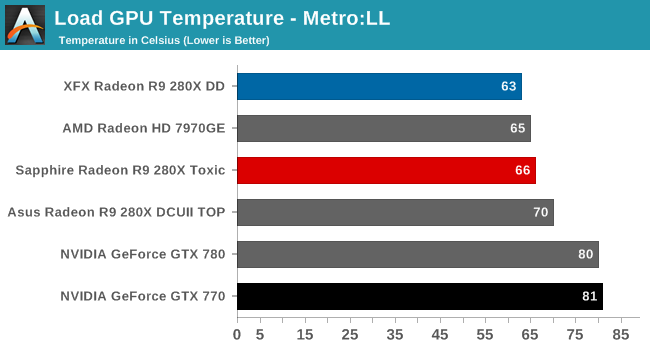
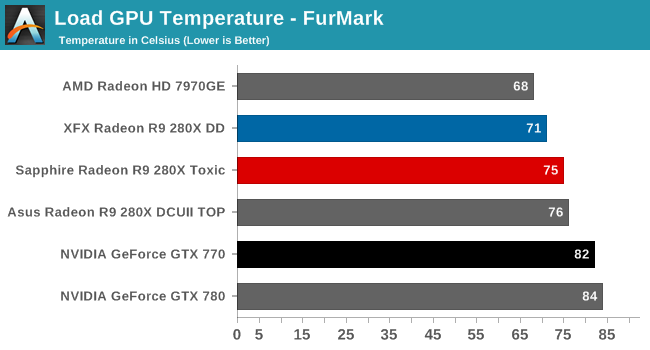
Considering the power numbers we just saw, Sapphire’s Tri-X cooler is earning its keep and then some. 66C under Metro is doing quite well for an open air cooled card drawing this much power, and the fact that FurMark temperatures only go to 75C despite the extreme power load there only further proves that the Tri-X cooler is up to the task for the Toxic. In spite of the high power draw, the card will have no trouble keeping up.
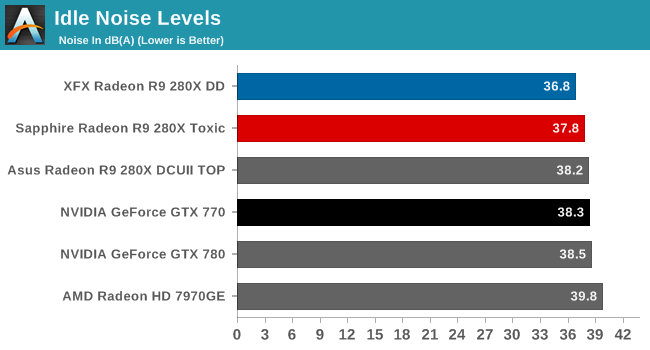
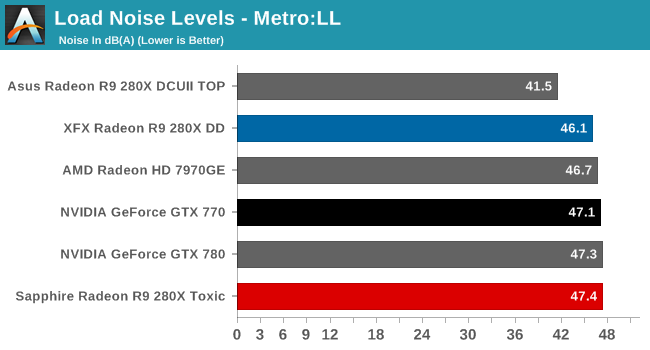
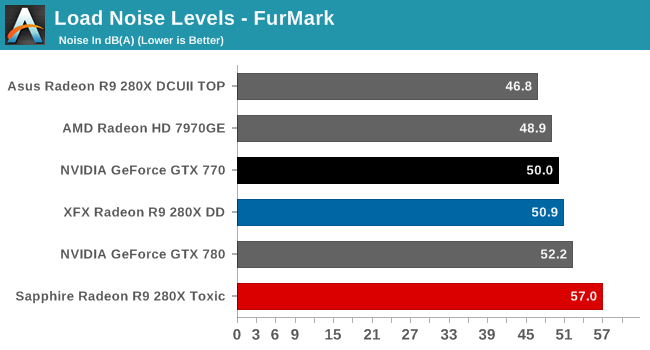
Finally our look at noise is something of a mixed bag for the 280X Toxic. The noise levels under Metro aren’t bad, but they’re also not great. At first glance Sapphire’s fan curve may be a bit aggressive, which is why we have 66C temperatures next to a 47dB(A) noise level. Next to the stock-clocked XFX card that’s a negligible increase in noise for a 13% performance increase, but the Asus card is something of a spoiler here. Asus in comparison gave up some cooling performance in exchange for lower noise levels and it shows. Sapphire could likely stand to be a bit less aggressive on cooling and bring those noise levels down, at least going by the conditions and results in our testbed.
FurMark on the other hand is outright loud, again going back to just how much power this card can draw when given a pathological use case and allowed to run free. I’m not sure if Sapphire could get away with a less aggressive fan curve here given the 75C temperature that goes with this noise level. Our testing methodologies don’t capture noise levels for other games, but based on our testing experience I don’t expect the card to get anywhere close to this under any game load, as those have always reflected what we see with Metro. Distributed computing/Bitcoin users likely wouldn’t be happy with this card though.
Ultimately Sapphire’s Tri-X cooler performs well under load here for typical workloads, and at least can easily keep up with the Toxic’s high power consumption under extreme workloads. The mixed results here ultimately come down to power consumption rather than the cooler itself.
Overclocking
Our final evaluation criteria is overclocking. And this will be short and sweet, as the 280X Toxic isn’t really designed for end user overclocking in the first place. Without voltage adjustment and already shipping at clockspeeds towards the tail end of the curve for the Tahiti GPU, there was absolutely no GPU overclocking headroom for our sample. It was rock solid at stock, but even 10MHz more would eventually result in artifacts when validating the overclock.
Every card will be different of course, and we certainly expect some 280X Toxic cards to have some unexploited headroom, but in the case of our card there was none to be found. Sapphire has fully exploited the available headroom of the GPU in their factory overclock.
| Radeon R9 280X Overclocking | |||||
| Sapphire Radeon R9 280X Toxic | XFX Radeon R9 280X DD | Asus Radeon R9 280X DCU II TOP | |||
| Shipping Core Clock | 1100MHz | 850MHz | 970MHz | ||
| Shipping Boost Clock | 1150MHz | 1000MHz | 1070Mhz | ||
| Shipping Memory Clock | 6.4GHz | 6GHz | 6.4GHz | ||
| Shipping Boost Voltage | 1.256v | 1.2v | 1.2v | ||
| Overclock Core Clock | 1100MHz | 880MHz | 1010MHz | ||
| Overclock Boost Clock | 1150MHz | 1030MHz | 1110MHz | ||
| Overclock Memory Clock | 7GHz | 6.6GHz | 6.8GHz | ||
| Overclock Max Boost Voltage | 1.256v | 1.2v | 1.263v | ||
Now the memory overclock on the other hand was more promising. We were able to get our card up to 7GHz, 600MHz (9%) over the shipping memory frequency and a full 1GHz over what the Hynix modules on the card are technically rated for. Of course the 280X already has so much memory bandwidth that the payoff from additional memory bandwidth isn’t quite as great as say a GTX 770, so coupled with the lack of a core overclock the performance gains are miniscule.
While we’re on the subject, it’s worth pointing out that the 280X Toxic has the highest PowerTune limit of any Tahiti card we’ve tested thus far. Unlike every other card, which tops out at +20% (for 300W or so), the Toxic can go to a full +50%, or somewhere north of 375W. For our testing purposes we stuck with 20% for consistency – the additional headroom wouldn’t be of any value in our games as far as we can tell, as opposed to letting FurMark go nuts – but if it were possible to do voltage adjustments on this card, hardcore overclockers would certainly have a lot of headroom for their water/exotic cooled setups.

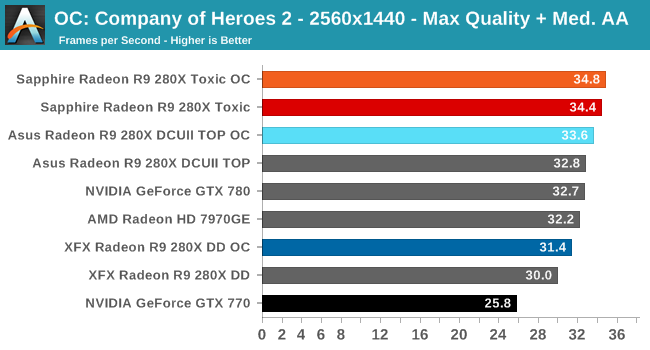
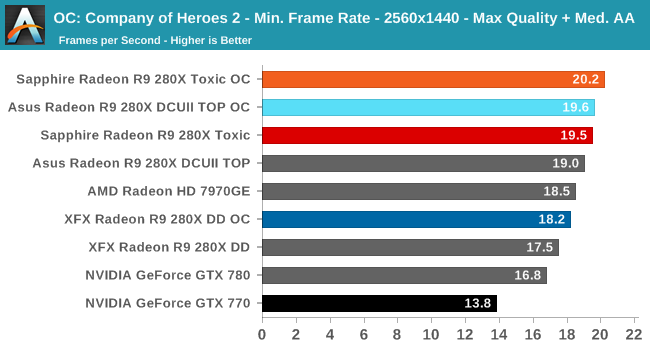
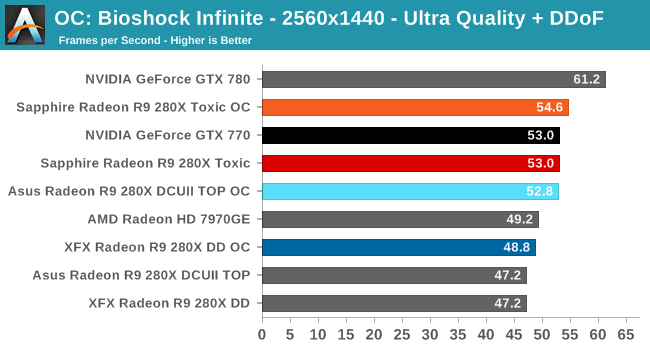
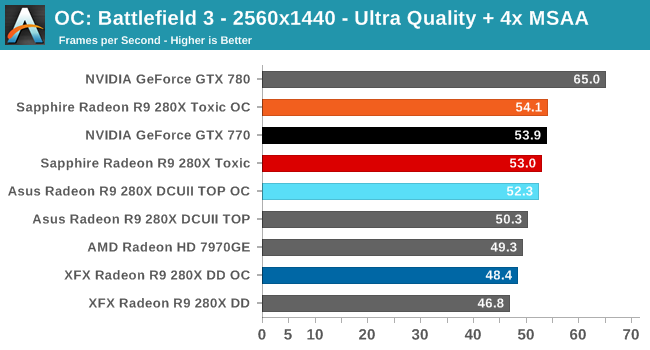
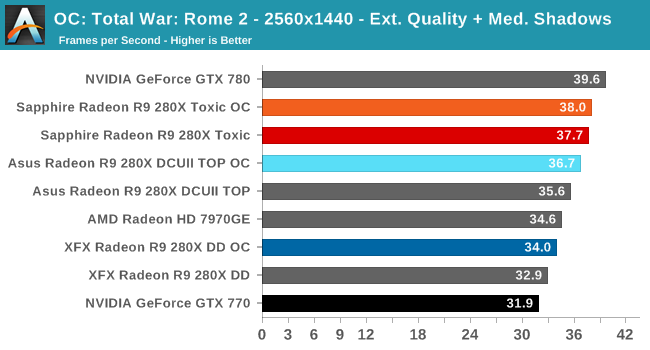
Despite the lack of gains from overclocking, the 280X Toxic is still the fastest 280X card even at stock. Our second best overclocking 280X is the Asus card, which topping out at a boost clock of 1110MHz still falls short of what the Toxic can achieve, and that was after supplying the Asus card with additional voltage. Undoubtedly some 280X cards with voltage adjustment will do better, but our results do paint a very convincing picture for just running the 280X Toxic at stock and ignoring all other cards, with or without overclocking.
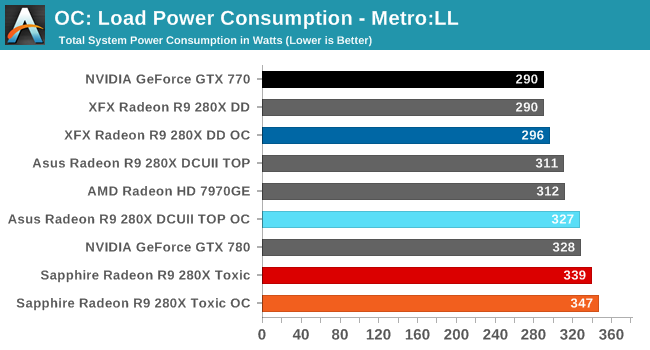
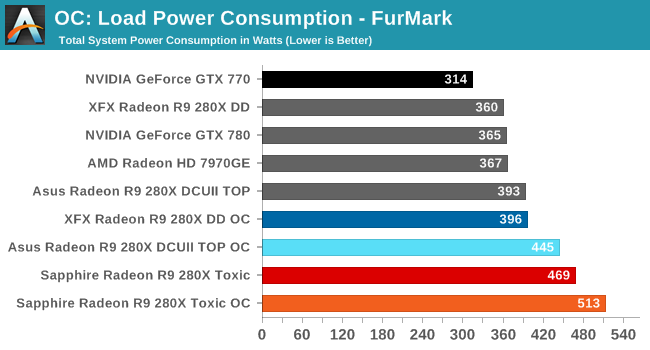

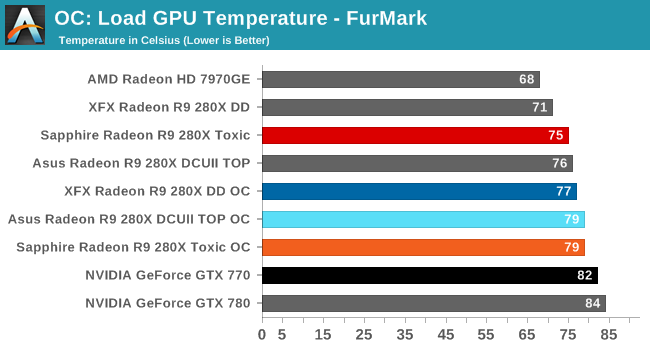
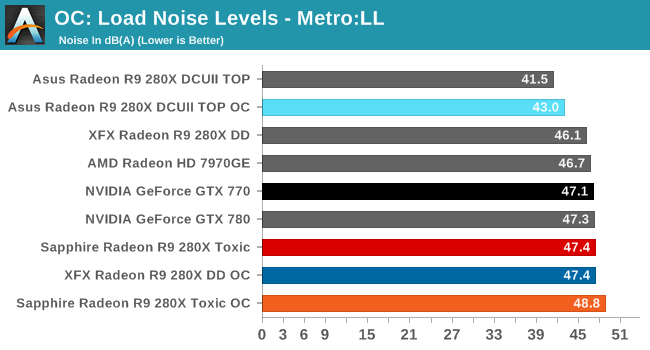
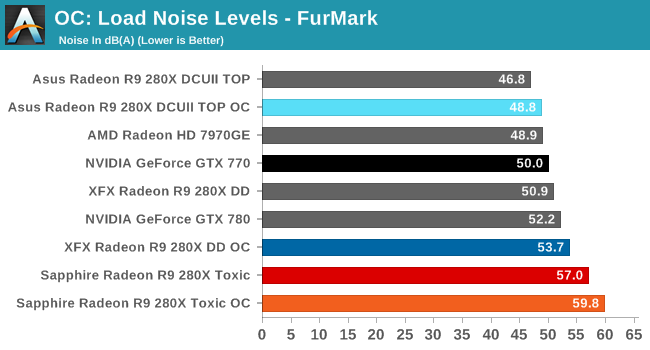
Since we can’t increase the GPU clock or the voltage of the 280X Toxic, the power/temp/noise hit is immaterial under Metro and other gaming workloads. You get almost nothing extra in performance for almost nothing extra in power/temp/noise. With our overclocked results thrown into the mix we can also see that while the stock 280X Toxic outperforms even our overclocked Asus 280X in gaming performance, it also does so while drawing more power than said overclocked Asus card. Clearly nothing is free here; more performance will cause a notable increase in power consumption.
Moving on to FurMark, with that 20% PowerTune increase FurMark absolutely goes nuts. 519W at the wall off of a single card is well out there, and the cooling performance also reflects this. This is all the more reason to leave the 280X Toxic at stock.
Final Words
Bringing our review of Sapphire’s R9 280X Toxic to a close, our experience with the card and our results prove that Sapphire has fundamentally achieved what they have set out to do: they’ve put together the fastest R9 280X card. It’s 13% faster than a stock 280X and it’s still 5% faster than the factory overclocked Asus card we looked at earlier this week. Out of the box the Toxic even maintains a hair’s lead over the Asus card when the Asus card is overclocked, which means we’re looking at a card that’s arguably competitive at stock with end user overclocked cards.
With that said while this isn’t necessarily a head-to-head article between the 280X Toxic and the Asus 280X DirectCU II TOP, it’s a logical comparison we have to make given the fact that both are factory overclocked 280X cards shooting for strong out of the box performance. For gaming workloads the 280X Toxic cleanly and clearly beats the Asus card here by a meaningful performance amount. However Asus is absolutely a spoiler here due to their aggressive pricing and their very quiet cooler. Their 280X DCUII TOP can’t match the Toxic, but it’s $40 cheaper and over 5dB quieter. Consequently if all you want is the fastest 280X on the market then Sapphire’s 280X Toxic is clearly the card to get, otherwise the Asus card is worth a consideration for its better price/performance ratio and cooling performance. As is almost always the case for factory overclocked cards there is a price to pay for the very fastest card, both in literal cost and in power and acoustics.
Meanwhile we’ll also quickly point out that the 280X Toxic ends up being faster than a stock GTX 770 by several percent for $50 less. But that’s a tricky comparison at best since we’re now comparing different cooler types (blower versus open air), a significant difference in power consumption, and it doesn’t take into account any of the customized GTX 770 cards. But it’s at least food for thought.
On a final note, since we’re looking at AMD’s second-tier cards – 290X is still due to arrive – given Sapphire’s $349 MSRP any purchasers may want to hold off for a bit until we have pricing and performance information for AMD’s new top-tier lineup. If they were to deliver a strong $400 card then the 280X Toxic likely wouldn’t make as much sense. But that’s something we won’t know for sure until the 290X is launched. It is however something to at least consider given the significant mark-up on the 280X Toxic over a standard 280X.

